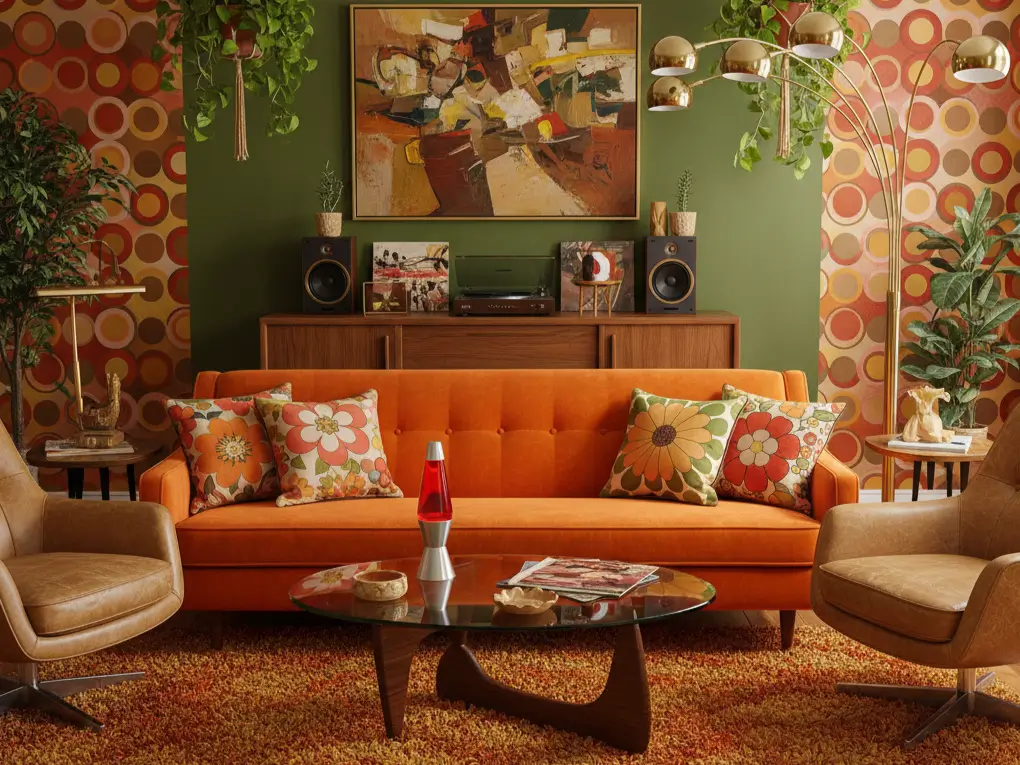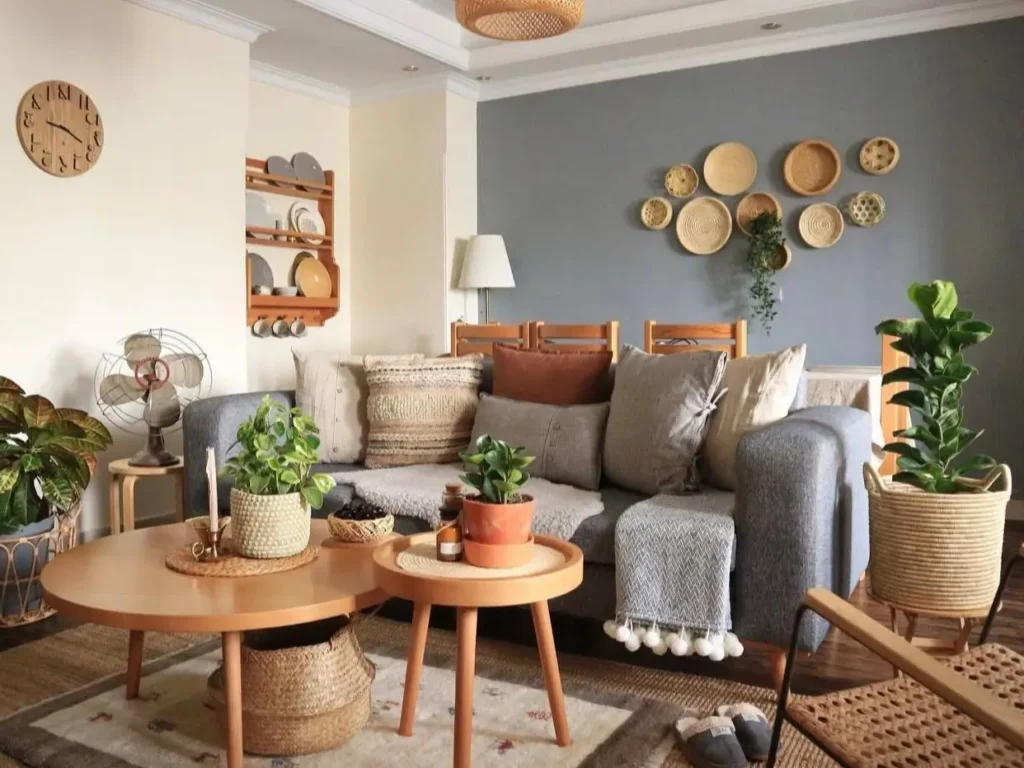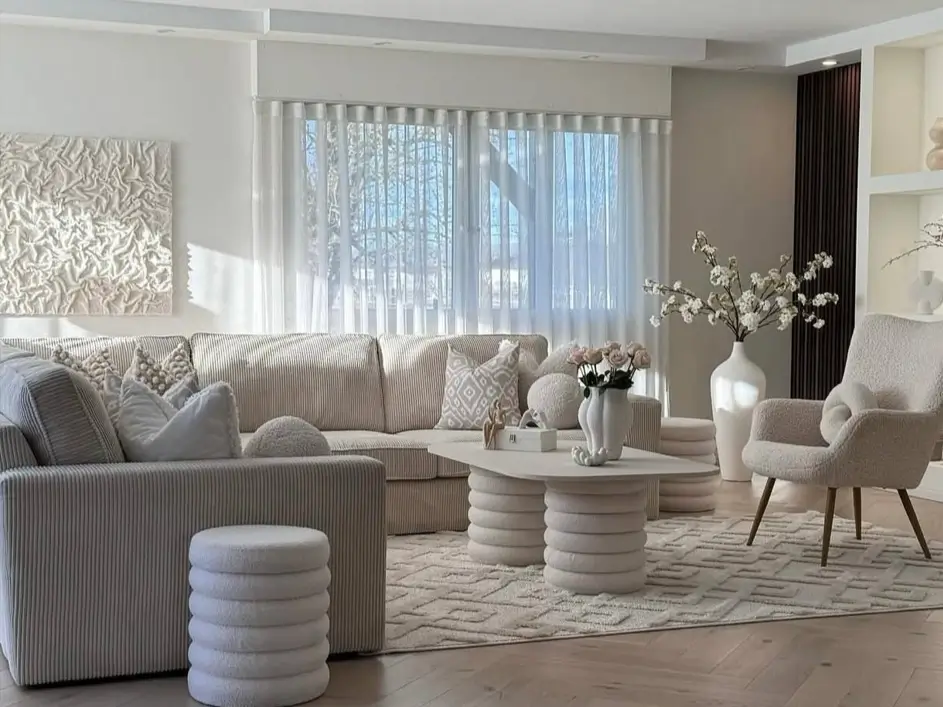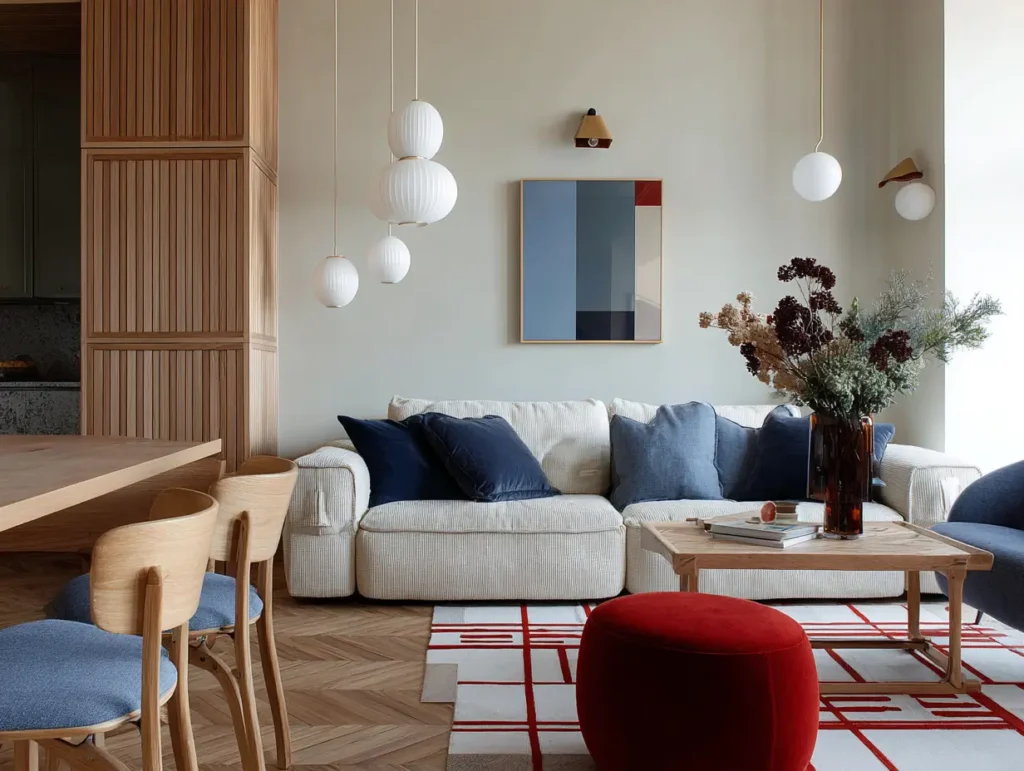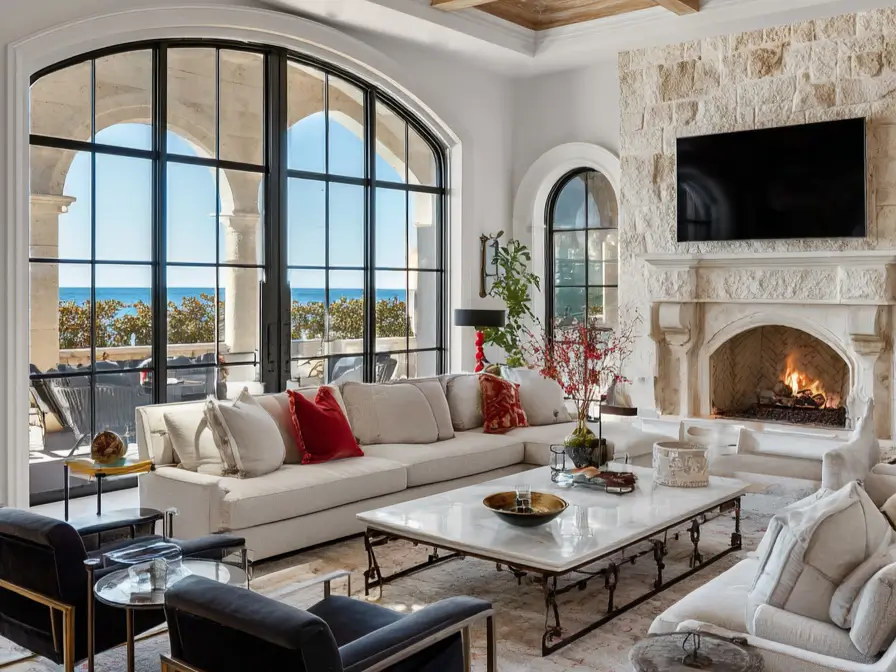The design world is once again embracing 70s living room decor, a style defined by its undeniable warmth, connection to nature, and bold personality. Today’s interpretation moves far beyond just shag rugs, focusing instead on sophisticated blends of earthy color palettes, sculptural furniture, and rich organic textures that feel both nostalgic and refreshingly modern.
Mastering the 70s retro living room is about curation, not just collection. The key to this 70s living room design lies in balancing its most iconic elements. It’s about learning how to layer graphic patterns, mix wood tones, and place statement lighting in a way that feels personal and inviting, not like a time capsule.
Whether you are planning a complete redesign or simply looking for inspiration, these 29 inspiring 70s living room ideas offer practical ways to infuse the era’s timelessly cool style into your home. We will explore the core principles and design ideas you need to curate a comfortable and stylish space.
Key Takeaways for 70s Living Room Decor
- Color Palette: The style is built on a foundation of warm, earthy tones like burnt orange, harvest gold, avocado green, and terracotta.
- Iconic Furniture: Seating is low-profile, sculptural, and comfortable. Key pieces include modular sofas, statement lounge chairs, and teak or walnut credenzas.
- Pattern & Texture: This look is highly tactile, layering plush shag rugs, velvet upholstery, and natural materials like wood paneling and rattan.
- Personal Touches: The style is finished with eclectic accessories, such as macrame, an abundance of houseplants, sculptural lighting, and curated gallery walls.
The Signature 70s Color Palette
The quickest way to channel a 70s aesthetic and build your 70s retro living room is through color. The era was defined by a shift away from bright, poppy colors toward warm, grounded, and earthy hues. Palettes were saturated and cozy, with harvest gold, avocado green, burnt orange, terracotta, and deep chocolate browns reigning supreme. These colors were used confidently, often across walls and large upholstery pieces.
1. Embrace Earthy Tones
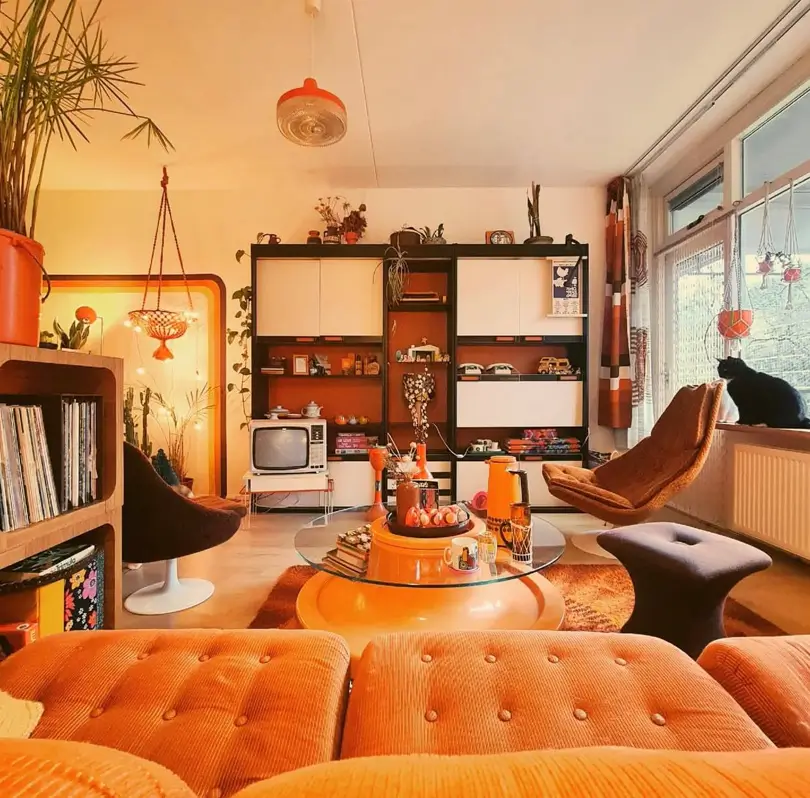
Warm, earthy colors are foundational to this look. Saturated oranges, deep browns, and harvest golds create an inviting atmosphere. See how this space layers these tones, from the tufted corduroy sofa to the patterned rug, for a cohesive and nostalgic feel.
2. Pair Green and Orange
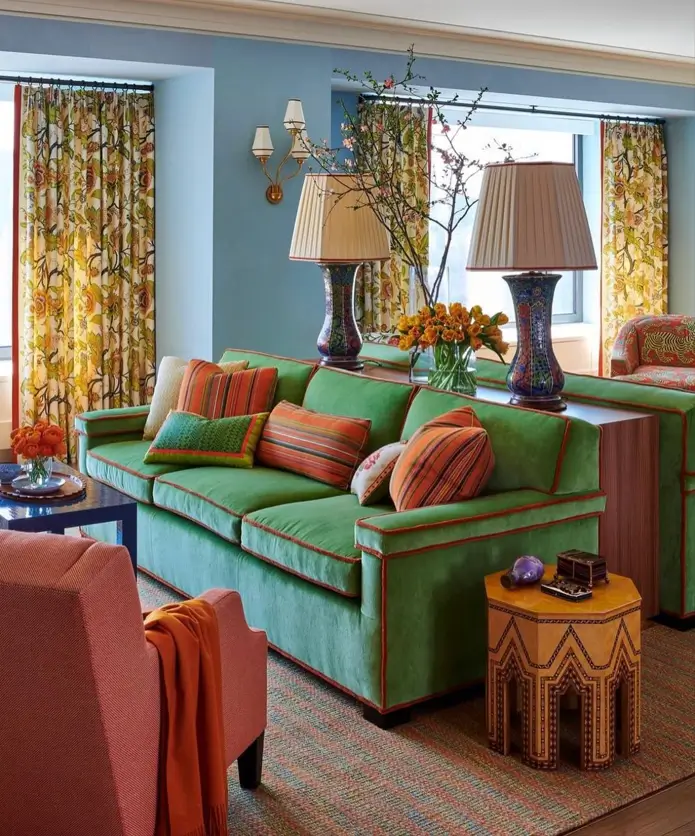
This 70s living room design uses a classic pairing of avocado green and bright orange. The sofa’s contrasting orange piping against the green upholstery is a sophisticated detail. Floral curtains and striped pillows add layered, period-appropriate pattern to the vibrant space.
3. Mix Tones and Textures
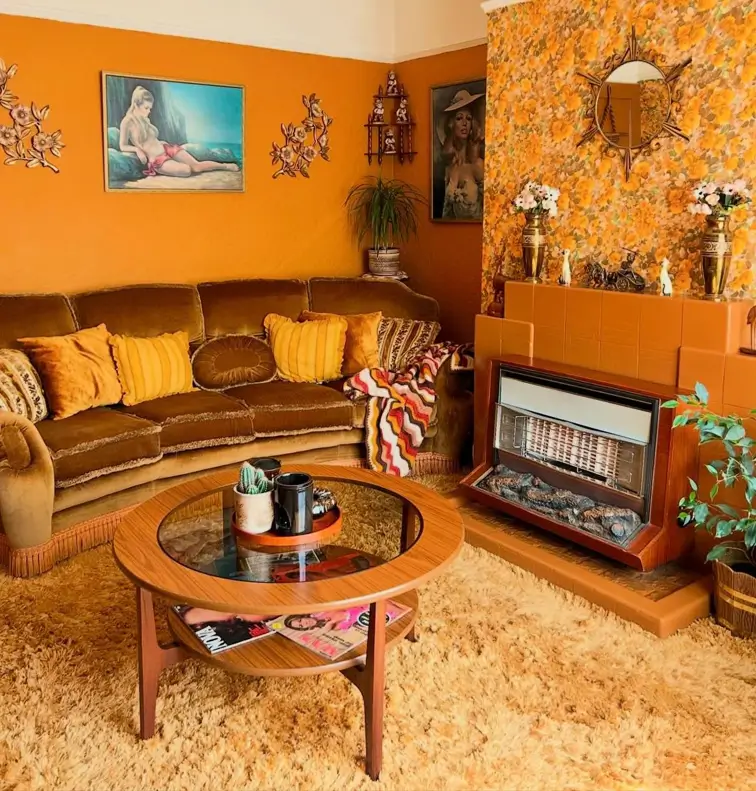
This 70s retro living room expertly mixes textures. A plush velvet sofa, fringed throw blanket, and deep-pile shag carpet create a rich tactile experience. The cohesive palette of gold, orange, and brown allows the floral wallpaper and painted walls to blend seamlessly.
4. Go Monochromatic
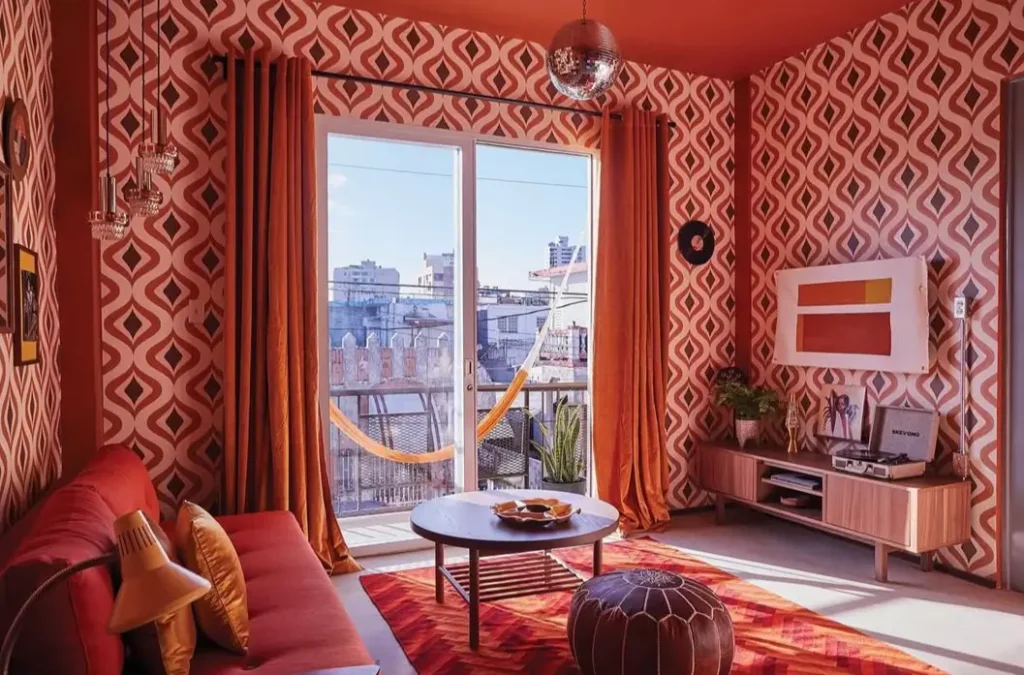
Committing to one color, like this room’s deep rust, creates an immersive 70s retro living room. The ogee-patterned wallpaper, curtains, and sofa are all in the same color family. This allows the disco ball and wood furniture to pop.
5. Embrace Bright Green
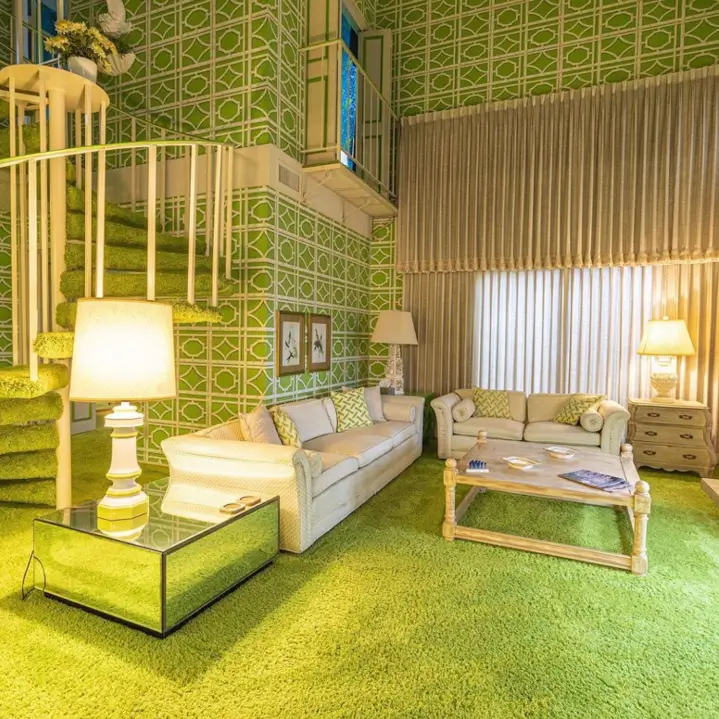
While earthy tones dominated, bright greens also had a moment. This space fully commits with matching geometric wallpaper and shag carpet. Neutral sofas and mirrored accents balance the bold color, creating a look that is pure 70s glam.
6. Use Harvest Gold
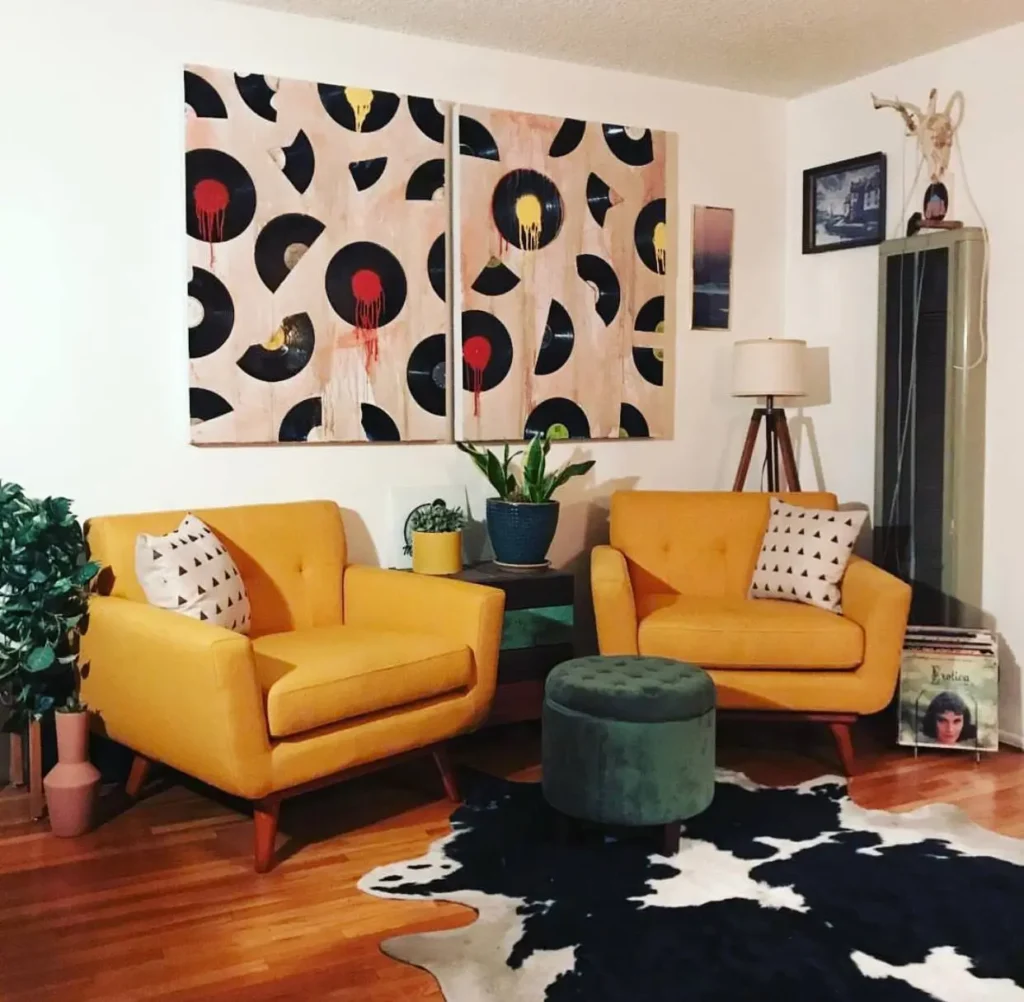
Harvest gold is a quintessential 70s color. In this modern interpretation, matching armchairs in the classic hue create a cheerful, retro focal point. Paired with a cowhide rug and music-themed art, the color adds nostalgic warmth without feeling dated.
Iconic Furniture for 70s Living Room Decor
Furniture for 70s living room decor prioritized comfort and conversation. Forms became softer, lower, and more sculptural, evolving from the cleaner lines of mid-century modern to embrace plusher, more organic shapes. Low-profile modular sofas invited lounging, while statement lounge chairs featured innovative materials. Natural wood, particularly teak and walnut, remained a staple.
7. Include Sculptural Seating
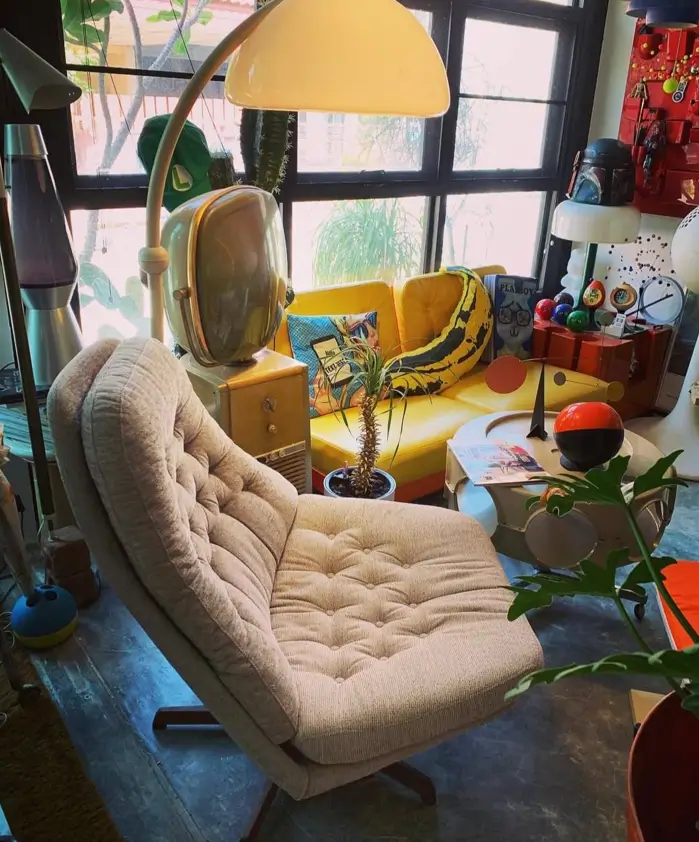
Furniture in the 70s often doubled as art. This tufted lounge chair features a sculptural, organic shape and a swivel base, common characteristics of the era. Its neutral upholstery balances the room’s more colorful elements, like the bright yellow sofa.
8. Try Modular Seating
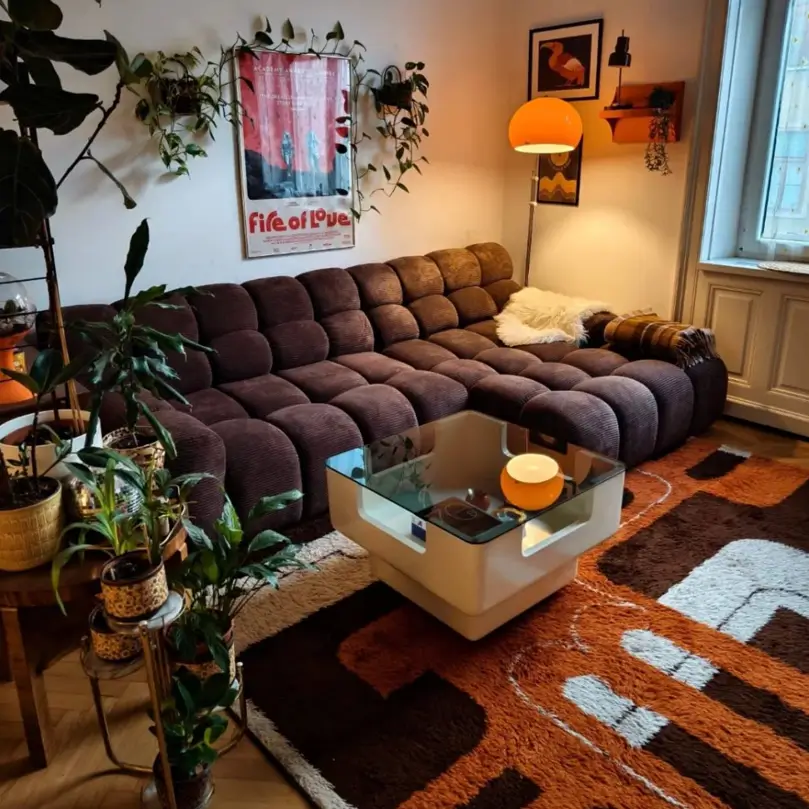
Low-profile, modular sofas were a 70s staple, prioritizing comfort and flexibility. This deep brown corduroy sectional features a distinct, channel-tufted design that invites lounging. It perfectly anchors the space, allowing the graphic rug and surrounding plants to stand out.
9. Focus on Curves
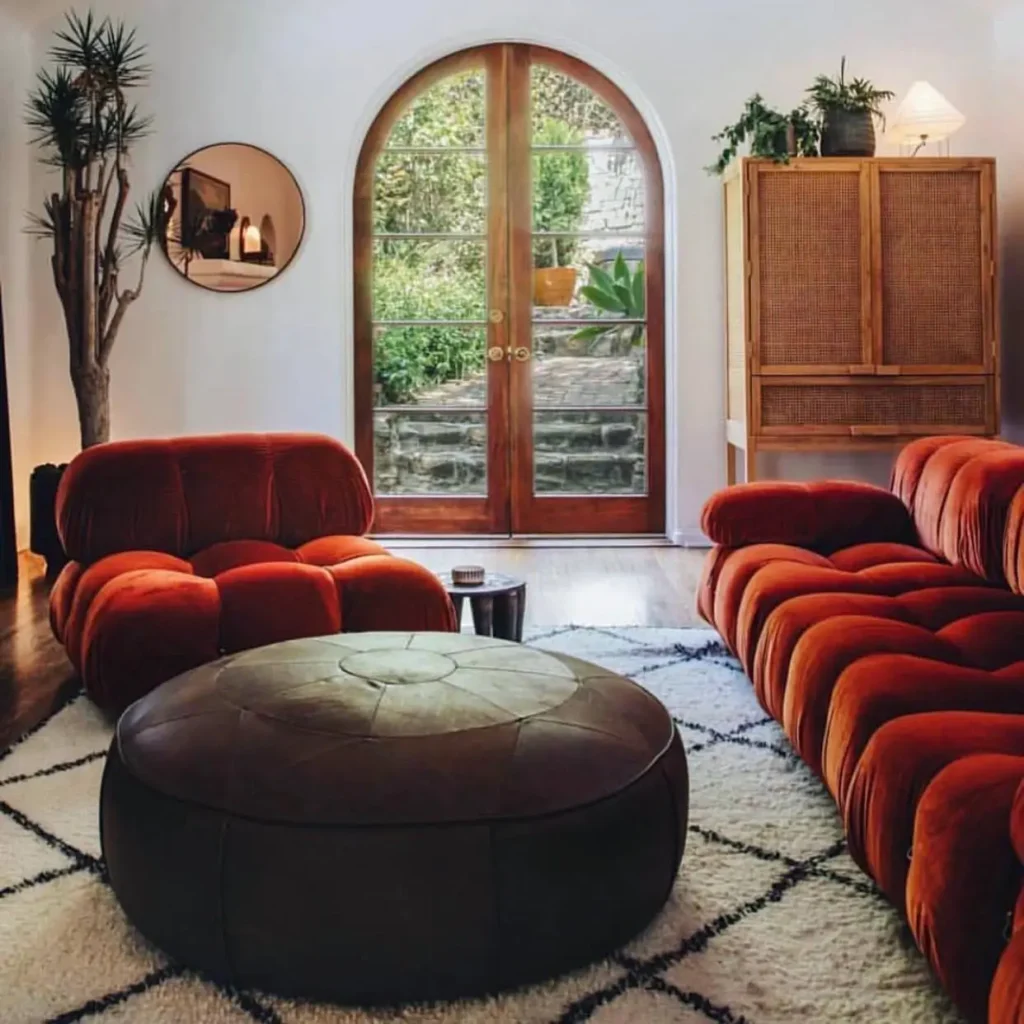
This 70s living room idea is defined by soft, curved silhouettes. The iconic, channel-tufted sofa and matching chair in burnt orange are quintessential examples. An arched doorway and a round leather ottoman reinforce the organic, flowing lines of the design.
10. Add Teak Furniture
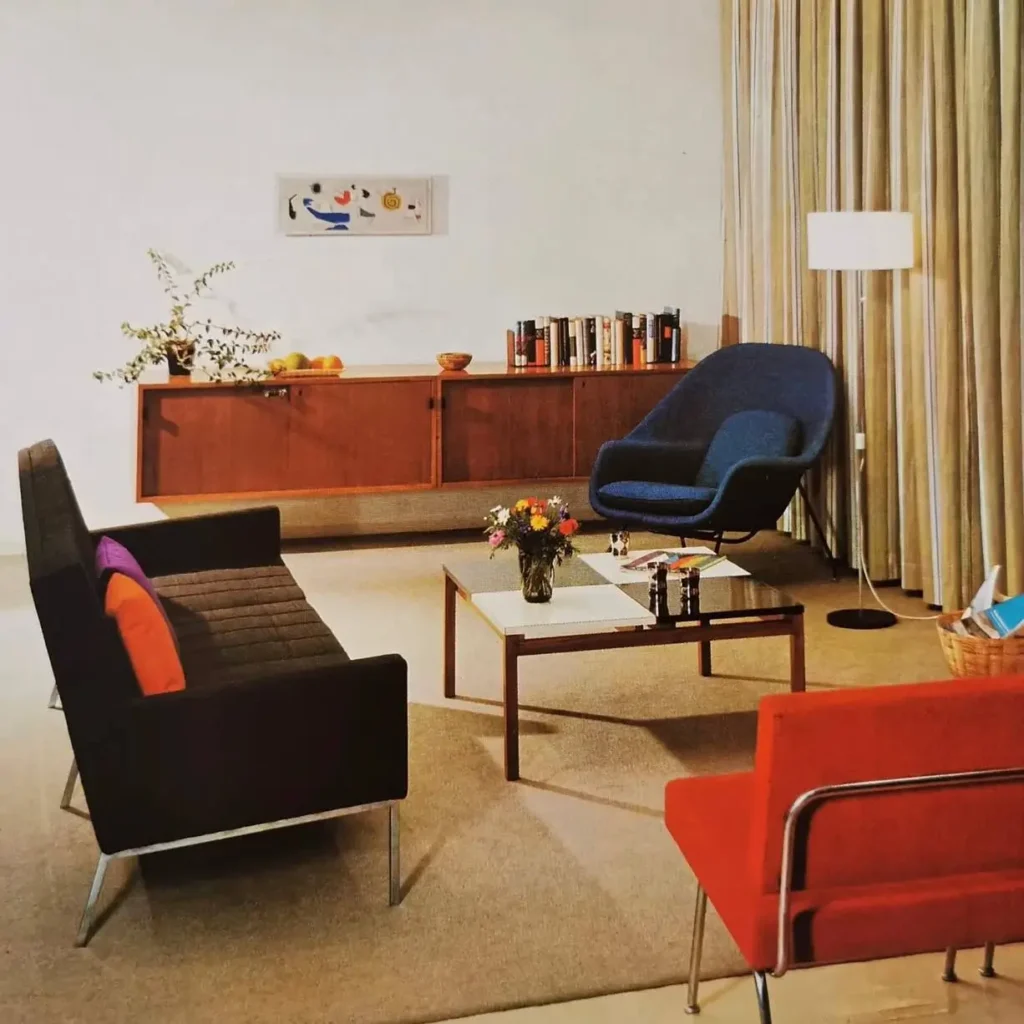
Teak or walnut credenzas and sideboards are foundational elements in a 70s retro living room. This piece features clean lines and simple hardware, true to its mid-century roots. Paired with sculptural chairs with chrome legs, it creates a sophisticated, minimalist take on the era.
Pattern and Texture in 70s Living Room Decor
Maximalism was embraced in 70s living room design through a rich layering of patterns and textures. This approach was all about tactile sensations. High-pile shag rugs, plush velvets, and cozy corduroys were mixed with natural materials like stone, rattan, and wood paneling. On the walls, bold geometric and large-scale floral wallpapers made powerful statements.
11. Layer Bold Patterns
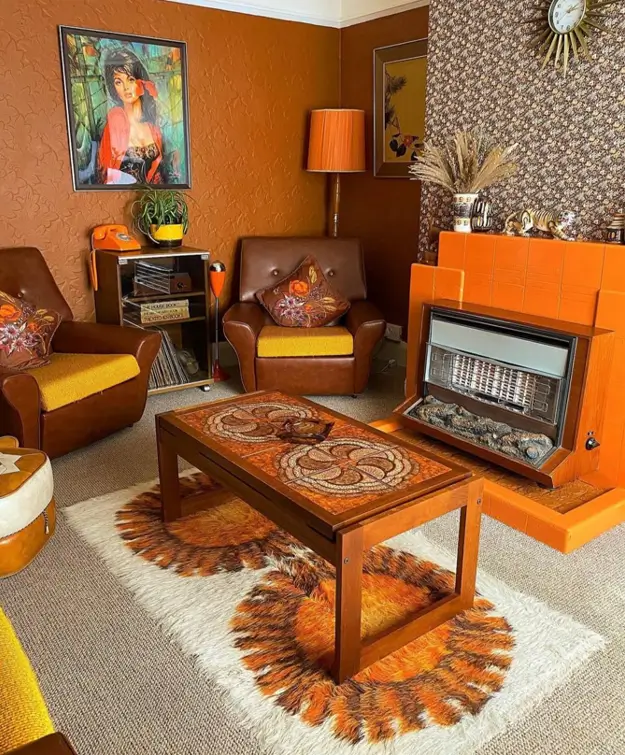
Pattern mixing is central to 70s living room design. Here, bold wallpaper, a graphic rug, and a tiled mosaic coffee table work together. A strict color palette of warm browns and oranges unifies the different elements for a cohesive, retro feel.
12. Commit to Graphic Wallpaper
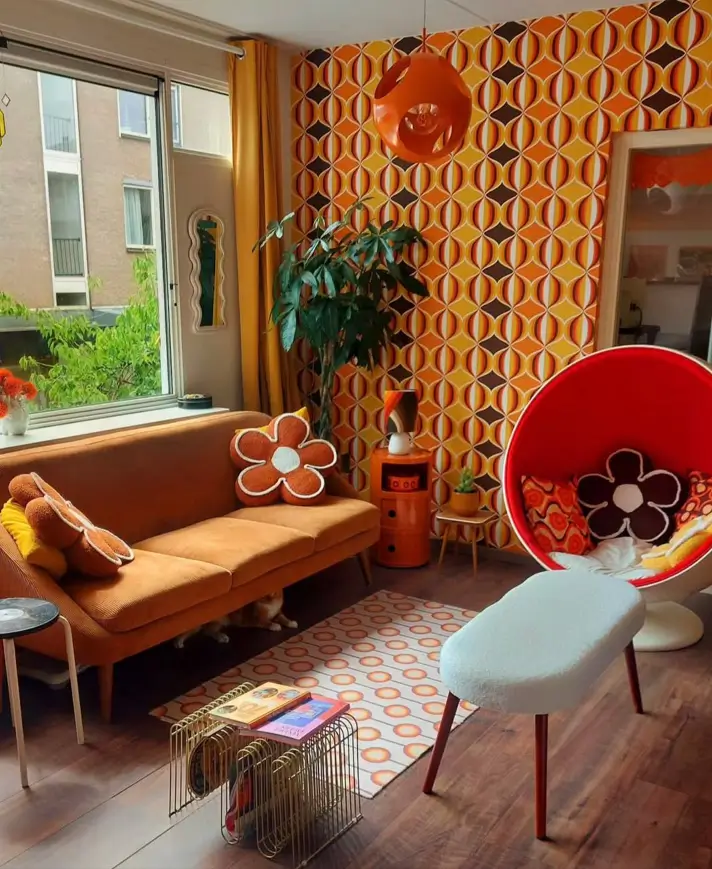
Graphic wallpaper is a hallmark of 70s living room design. This space uses a large-scale, geometric print to create a powerful focal point. Balancing the bold walls, simpler furniture shapes like the low-profile sofa and iconic pod chair prevent the room from feeling overwhelming.
13. Paint Graphic Stripes
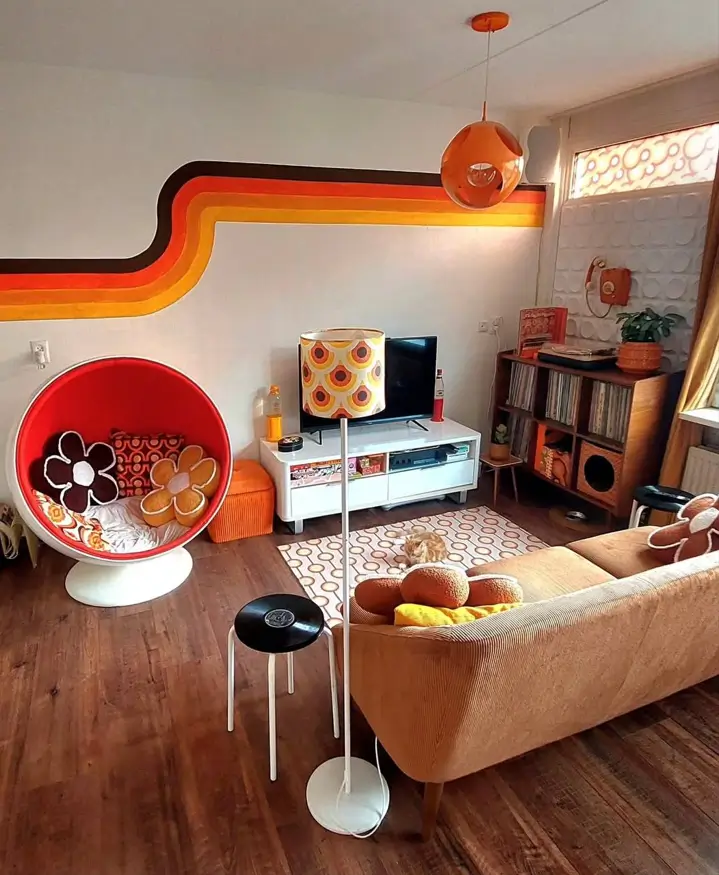
For a graphic punch withoutwallpaper, consider painted wall stripes. This design uses a classic 70s palette of orange, brown, and yellow to create a dynamic accent that flows around the room, tying together the furniture and accessories.
14. Anchor with a Shag Rug
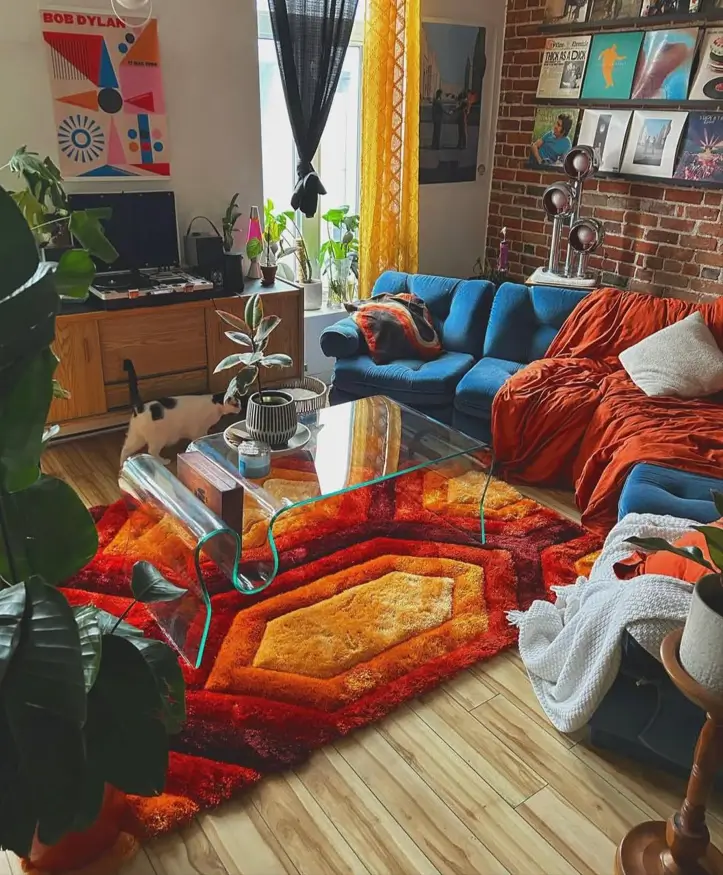
High-pile shag rugs instantly add 70s texture. This geometric-patterned rug anchors the room in warm, earthy tones. It creates a tactile foundation that contrasts beautifully with the exposed brick wall and the smooth, clear acrylic coffee table.
15. Layer Warm Textures
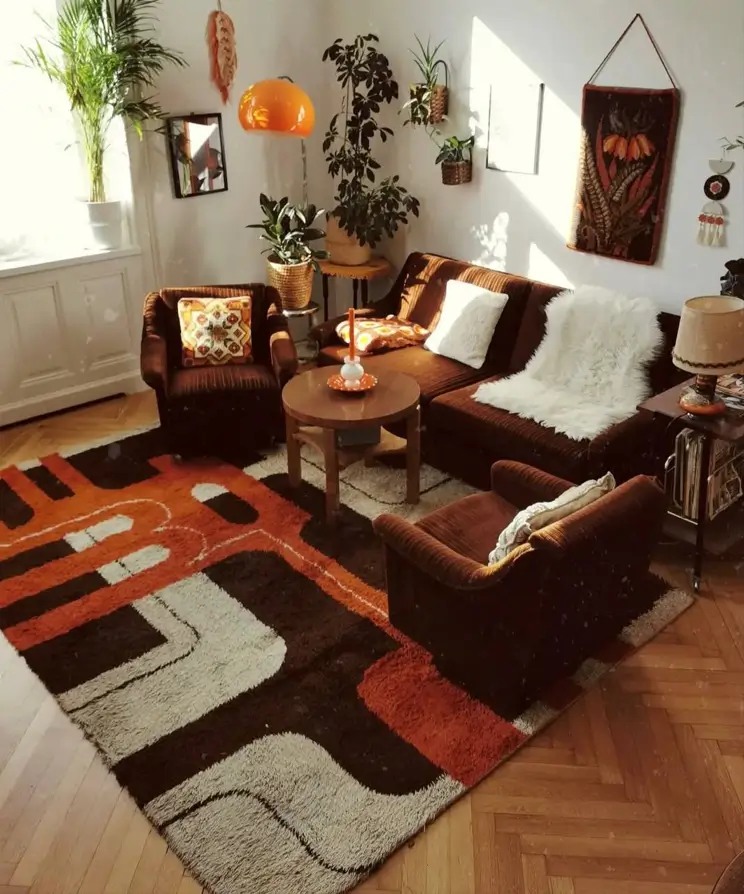
This room exemplifies a core 70s living room idea: textural layering. A bold, graphic shag rug sits on herringbone wood floors. Velour upholstery, soft knit pillows, and a fuzzy sheepskin throw add depth, creating an inviting and cozy environment.
16. Use Wood Paneling
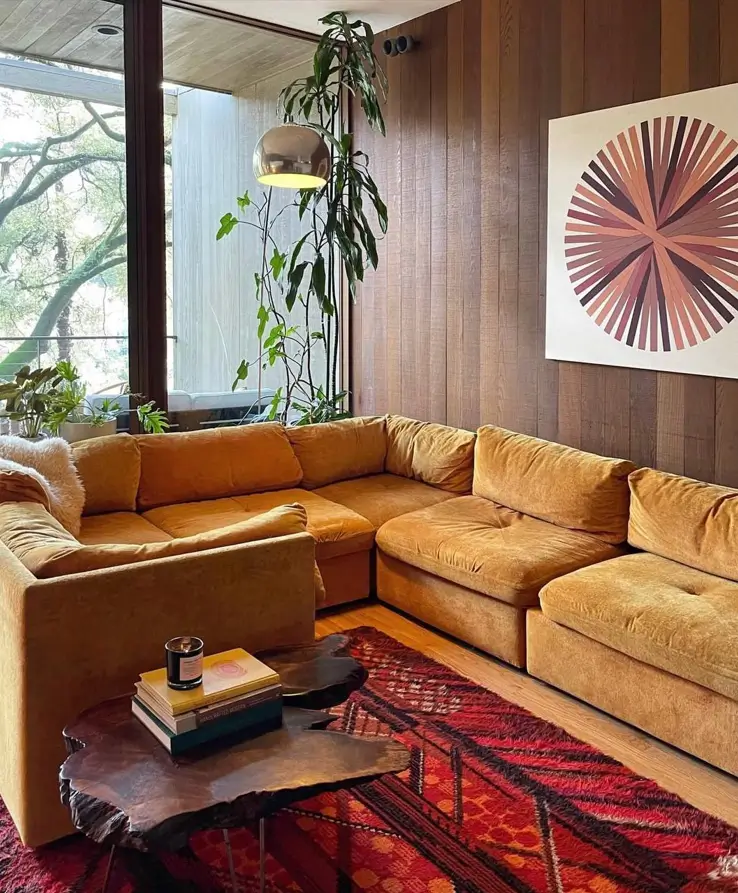
Vertical wood paneling brings natural texture and warmth, instantly evoking 70s living room design. It provides a rich, organic backdrop for the low-slung modular sofa. A live-edge wood coffee table and a patterned rug complete this nature-inspired palette.
17. Add Textile Wall Art
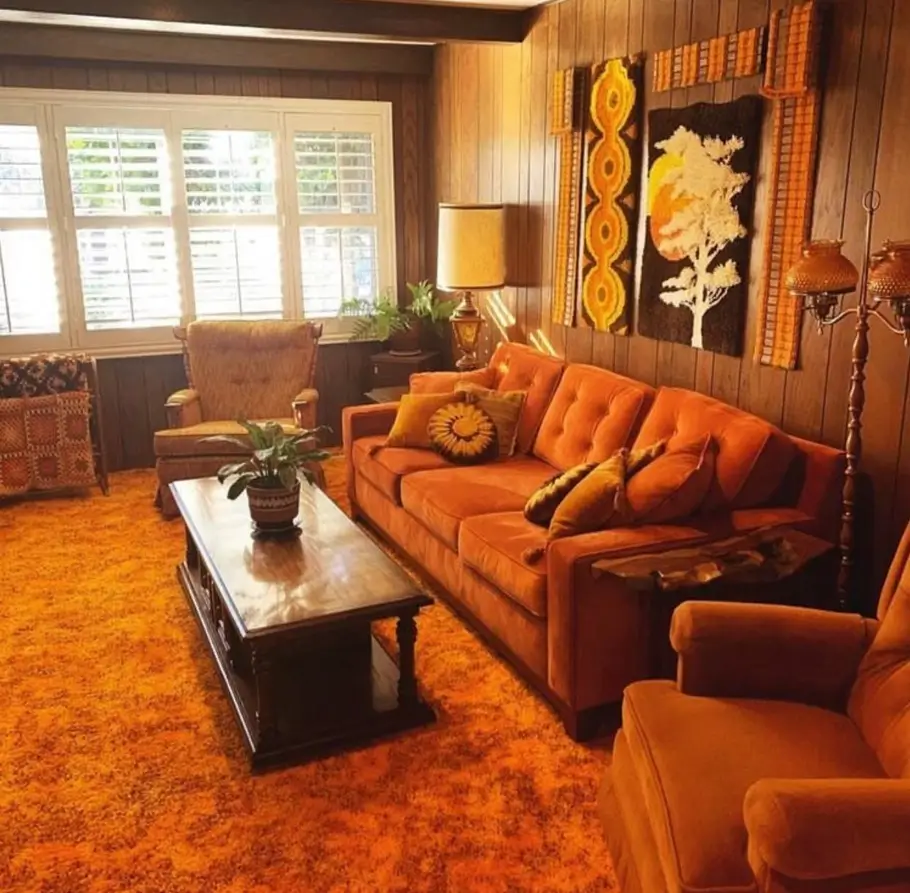
Woven tapestries or macrame hangings are perfect 70s living room ideas for adding soft texture to walls. These pieces, often in earthy tones, complement the wood paneling and velour sofa, enhancing the room’s cozy, layered feel.
18. Use Floral Curtains
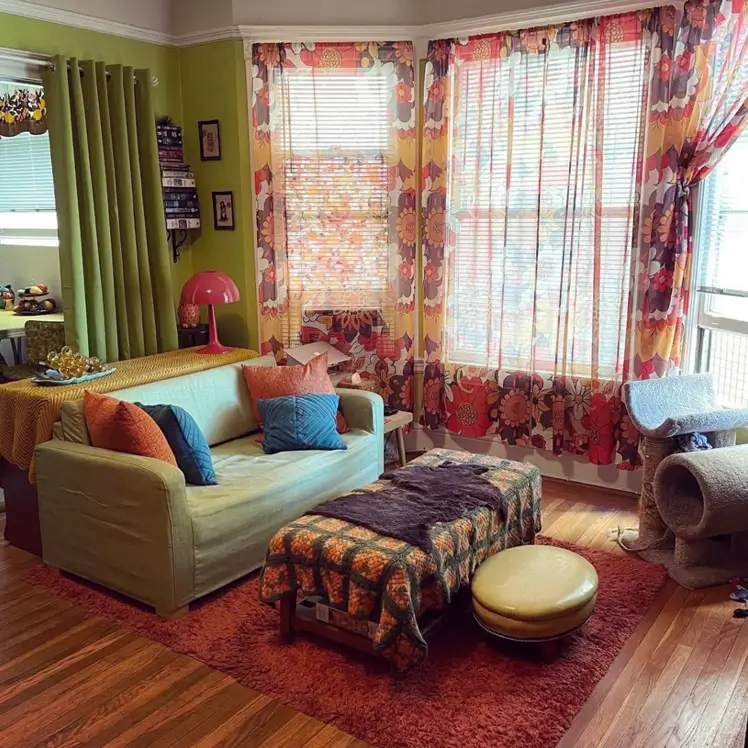
Large-scale floral patterns are quintessentially 70s. Here, sheer curtains featuring bold orange, red, and yellow flowers make a vibrant statement. They filter light beautifully and serve as the main pattern, balanced by solid colors on the walls and sofa.
19. Choose Tiled Tabletops
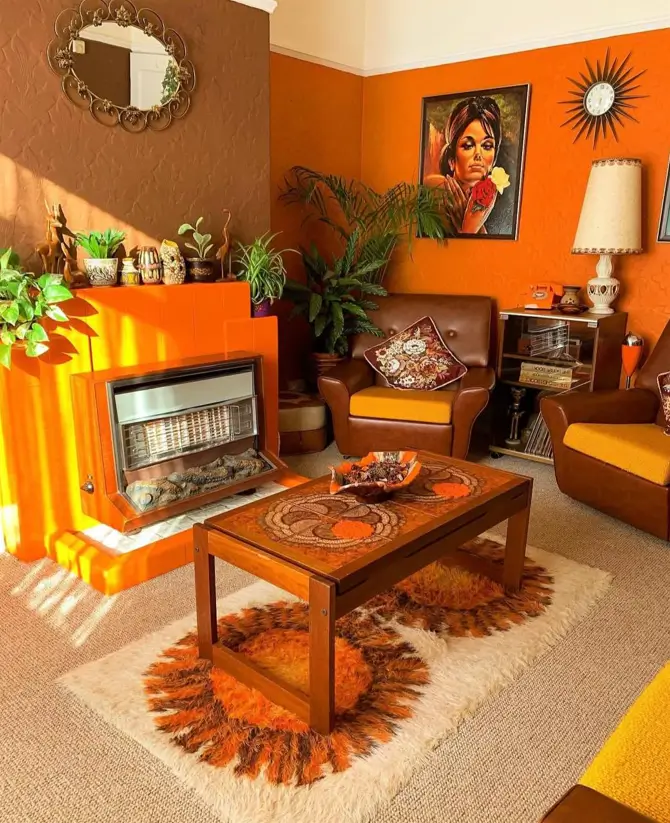
Mosaic or tiled coffee tables add an artistic, handcrafted element to 70s living room decor. This wooden table features an inset tile design that perfectly coordinates with the room’s orange and brown color story, acting as a functional centerpiece.
20. Mix Stone and Wood
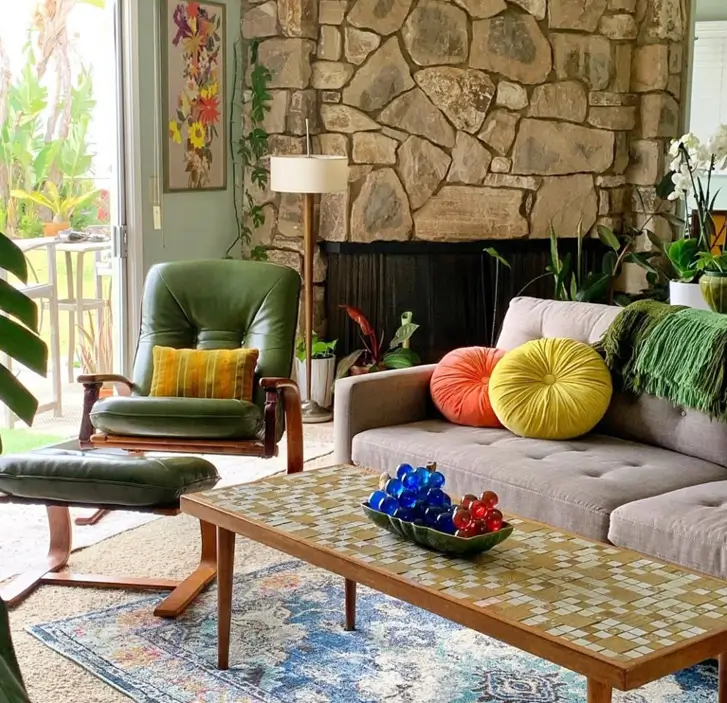
Natural materials were celebrated in 70s design. This living room features a dramatic stone fireplace, which provides a rugged, earthy texture. It contrasts beautifully with the warm wood tones of the lounge chair and tiled coffee table for a balanced look.
21. Install Slat Wood Walls
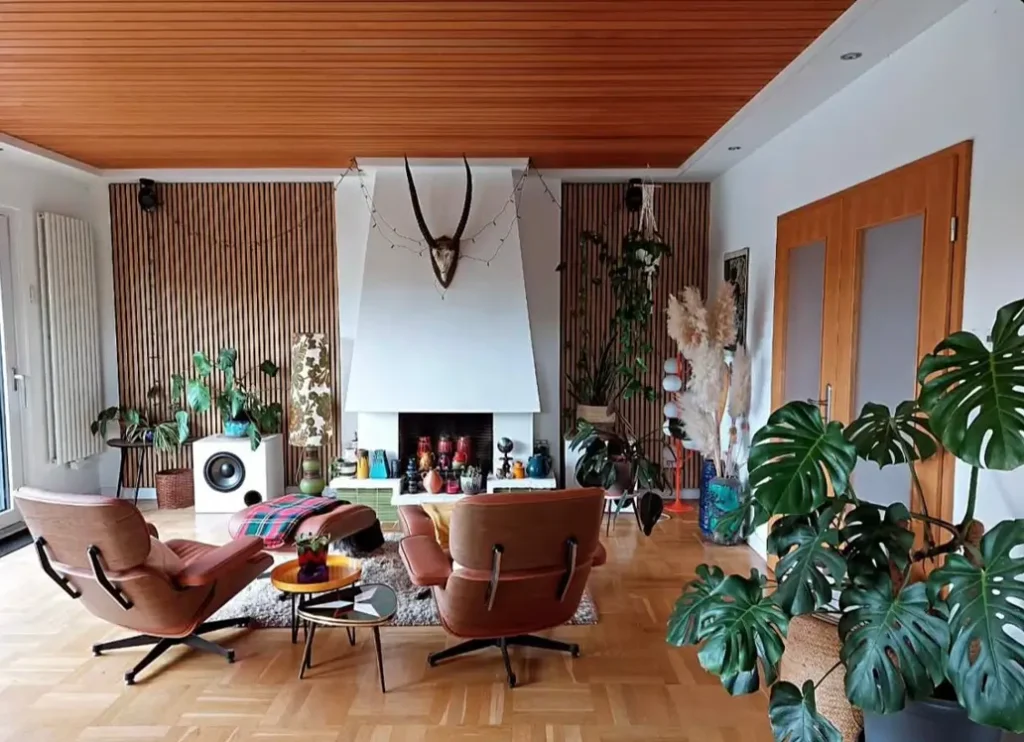
Vertical wood slats, used here on the ceiling and accent walls, are a sophisticated 70s living room idea. The clean lines guide the eye and and add architectural interest. This natural texture pairs perfectly with iconic lounge chairs and parquet floors.
Finishing Touches for a 70s Retro Living Room
The final layer of your 70s retro living room is about personality and eclecticism. This style blends seamlessly with bohemian touches like macrame plant hangers and an abundance of houseplants like ferns and spider plants. Lighting became sculptural, with chrome accents and smoked glass appearing alongside statement pendants and arc lamps. Gallery walls grew bold, filled with personal collections and abstract art.
22. Curate Gallery Walls
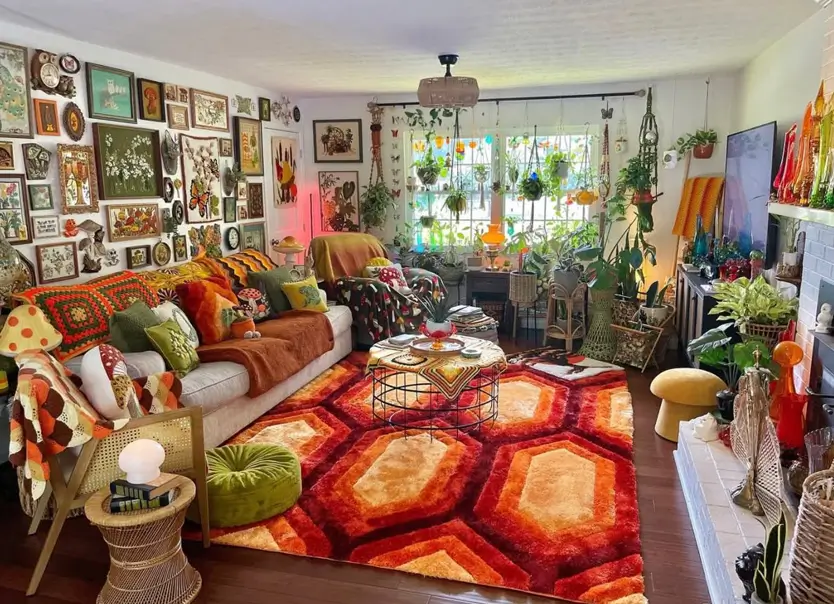
Maximalism was a key part of 70s decor. This space showcases a floor-to-ceiling gallery wall filled with eclectic art. Paired with numerous plants, crochet blankets, and a bold rug, the look is personal, collected, and brimming with personality.
23. Weave in Natural Materials
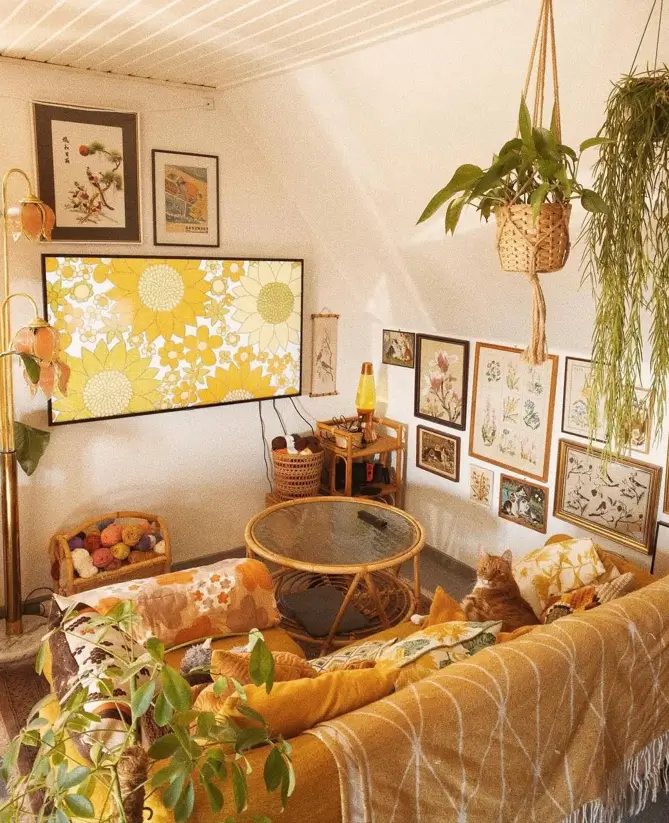
Rattan and wicker were go-to materials in the 70s for adding organic texture. This room uses a rattan coffee table as a centerpiece, pairing it with a harvest gold sofa and macrame plant hangers. Botanical prints round out the nature-driven, boho aesthetic.
24. Mix Old and New
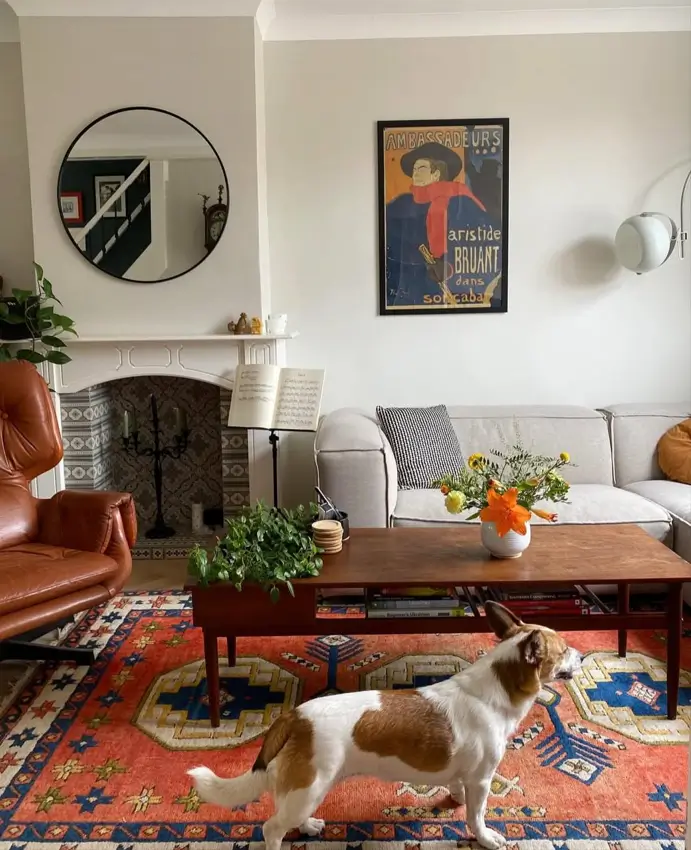
70s decor integrates beautifully with modern design. This space uses a neutral backdrop of white walls and a simple sofa to make the 70s elements stand out. A bold, geometric rug and a leather lounge chair add warmth and retro character without overwhelming the room.
25. Embrace Eclectic Seating
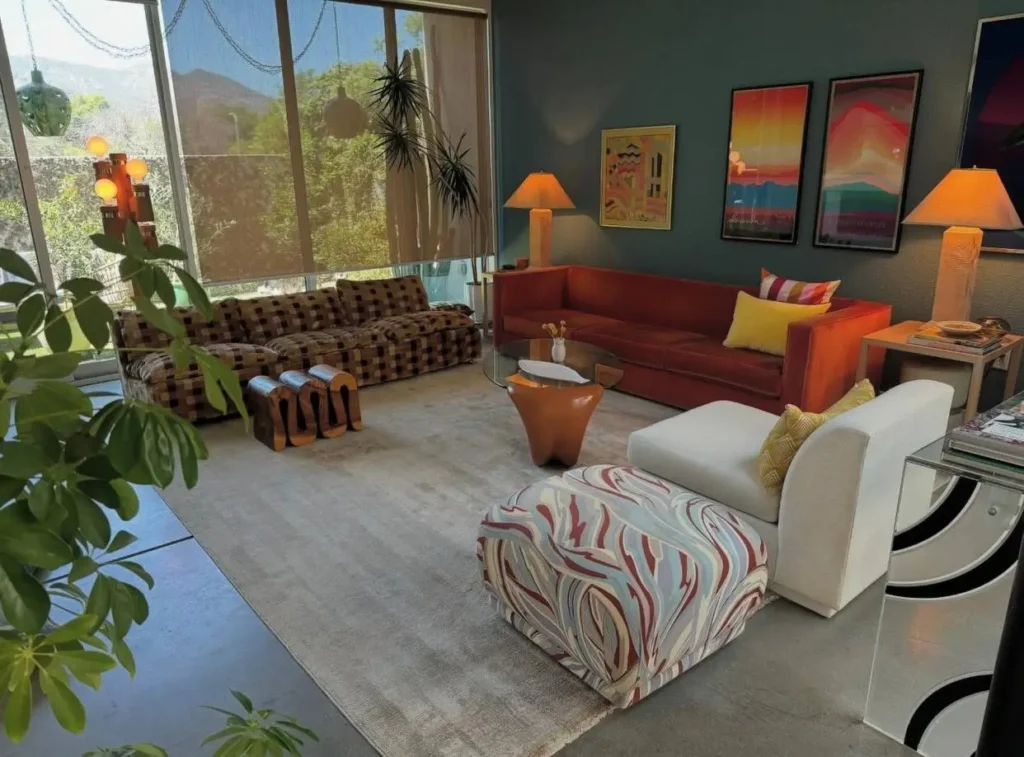
This space confidently mixes different 70s living room ideas. A rust-orange velvet sofa, a patterned loveseat, and a modern chair are all unified by a spacious layout and a deep teal wall color. Bold, graphic artwork completes this eclectic yet cohesive design.
26. Feature Iconic Lighting
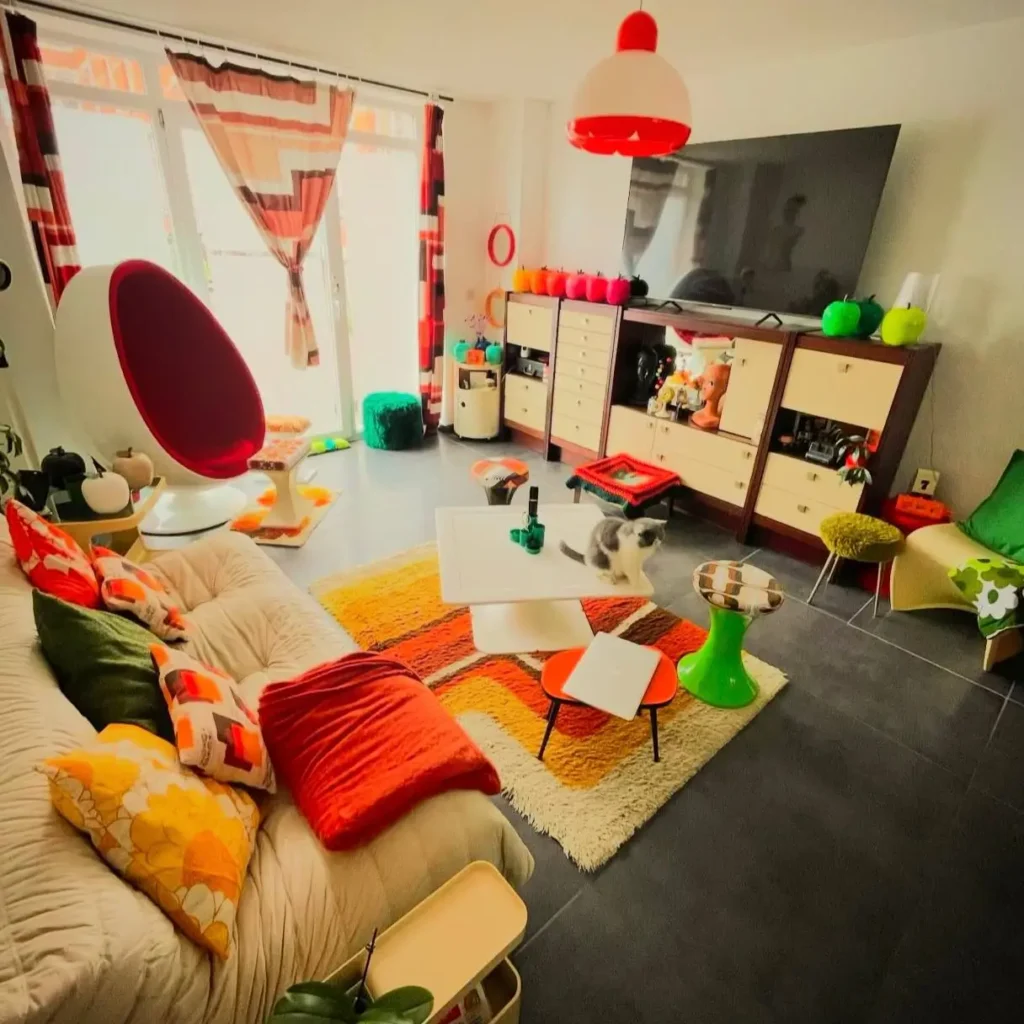
Statement lighting, like this red and white pendant, is an easy way to add 70s flair. Paired with an iconic ball chair, it creates a playful, retro-futuristic vibe. Colorful pillows and a geometric shag rug complete the vibrant 70s living room.
27. Try Bohemian Touches
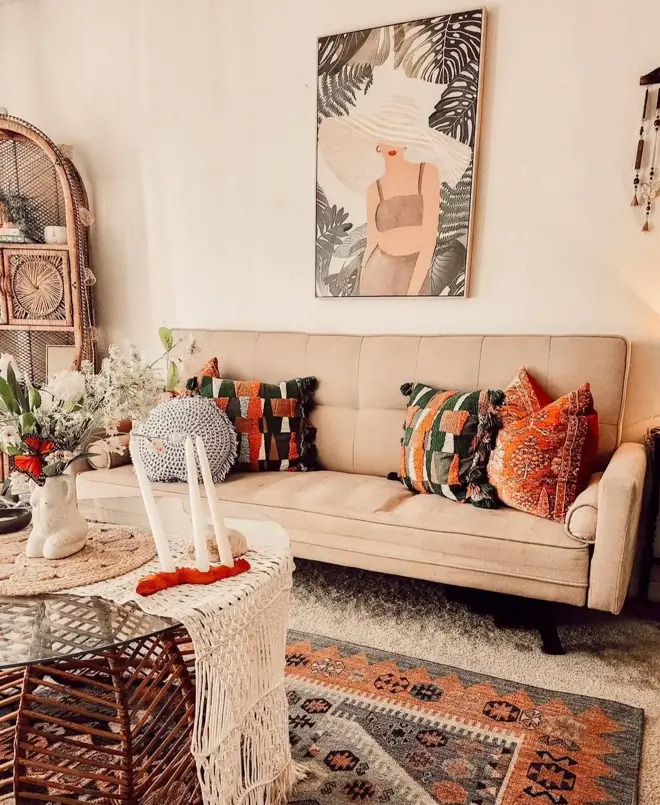
70s decor often overlaps with bohemian style. This room uses a neutral sofa as a base for rattan furniture, a macrame table, and heavily textured pillows. A patterned rug in earthy tones ties the eclectic, free-spirited look together.
28. Add Textured Pillows
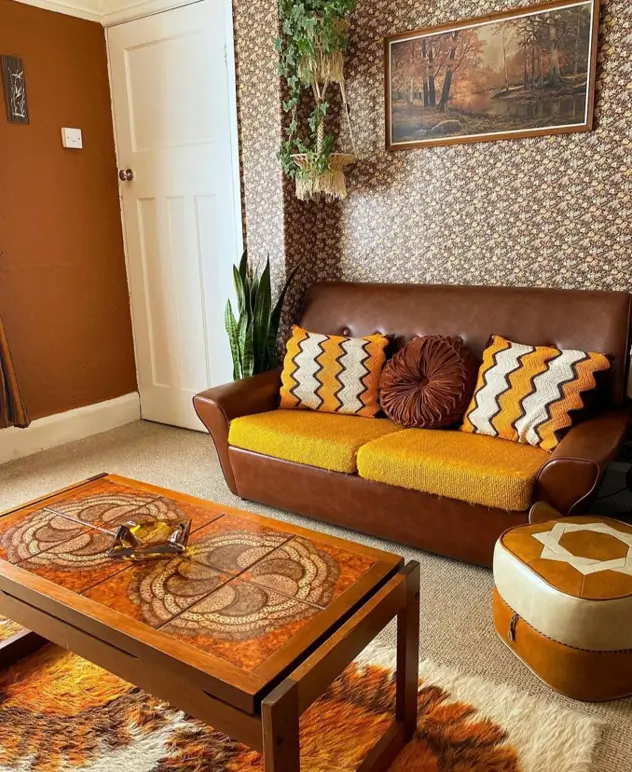
Crochet and knit pillows in bold, graphic patterns instantly add a cozy, handmade feel. Here, chevron and tufted round pillows pop against the two-tone sofa. They coordinate with the small-print floral wallpaper for a space that is layered yet balanced.
29. Curate Retro Artwork
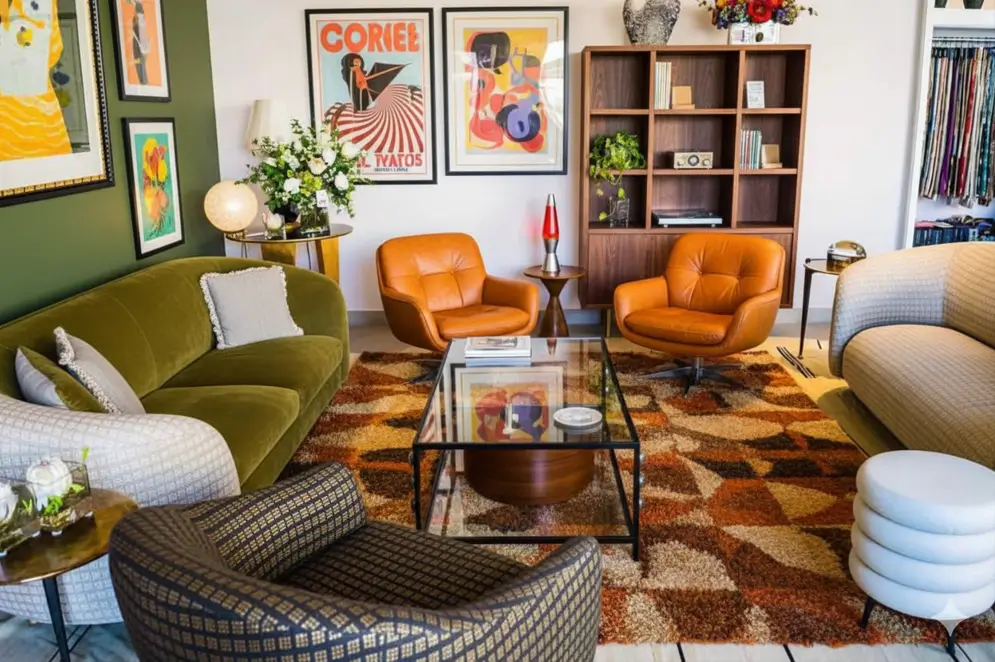
This 70s living room features a mix of iconic pieces.. The olive green sofa, orange leather swivel chairs, and a bold shag rug create a classic base. Retro-style posters and a lava lamp add curated, personal touches that complete the authentic 70s feel.
How to Integrate 70s Living Room Design
All this inspiration shows the “what” of 70s style, but the “how” is just as important. Integrating this look successfully is about balance. Here are four key principles to follow.
- Start With a Cohesive Palette: Begin by choosing a tight color palette of 3-4 earthy tones, such as cream, brown, and burnt orange. This will act as the “glue” to unify the different patterns and textures without the space feeling chaotic.
- Balance Modern and Retro: Avoid a “time capsule” look by aiming for an 80/20 balance. A modern 70s living room design feels fresh when you pair key retro pieces (like a shag rug or arc lamp) with clean, contemporary furniture.
- Prioritize Textural Layers: A 70s-inspired room should be tactile. Make a conscious effort to mix textures. Combine hard and soft elements (like smooth leather, plush velvet, knit throws, and natural rattan) to create depth and warmth.
- Source Strategically: Thrifting and vintage shopping can yield authentic finds. When sourcing, look for items with “good bones”—solid wood construction (like teak or walnut), quality materials, and interesting sculptural shapes. Many modern retailers now offer new pieces with classic 70s silhouettes.
A Final Word on 70s Style
Ultimately, the appeal of 70s living room decor—and all 70s interior design styles—lies in its warmth and personality. It is a style that invites you to lounge, connect, and fill your space with items that have character. By focusing on rich colors, tactile materials, and personal touches, you can create a space that feels both nostalgic and perfectly new.
READ NEXT: 23 Ways to Embrace 70s Bathroom Decor for a Modern Revival
Frequently Asked Questions
What are the key colors for 70s living room decor?
The core 70s color palette is warm and earthy. Focus on tones like harvest gold, avocado green, burnt orange, terracotta, and deep chocolate brown used on walls, furniture, and shag rugs.
What furniture is essential for a 70s retro living room?
Essential furniture includes low-profile, sculptural pieces like modular sectional sofas, lounge chairs with organic curves (in velvet or corduroy), and teak or rattan credenzas to complete the look.
How can I make 70s living room design feel modern?
Make it modern by balancing retro and contemporary. Pair key 70s accents, like a shag rug or a 70s-inspired color palette, with a modern, neutral sofa and clean, contemporary lines.
What about conversation pits?
Conversation pits are an iconic 7De feature. You can recreate the cozy, “sunken” feel (without renovation) by arranging low-profile modular sofas in a U-shape on a large, high-pile shag rug.
What are some simple 70s living room ideas to start with?
Start with high-impact, simple ideas: add a geometric shag rug, use velvet or corduroy pillows in earthy tones, or group leafy houseplants in rattan planters.

